
Cast * Interesting Facts * Behind The Scenes * Origins of the Story

Cast * Interesting Facts * Behind The Scenes * Origins of the Story
Directed by: Clyde Geronimi
Written by: Milt Banta & Winston Hibler
Music by: Tchaikovsky, George Bruns, Sammy Fain, Ted Sears
Released on: January 29, 1959
Running Time: 75 minutes
Budget: $6 million
Box-Office: $51 million in the U.S.
Note: This movie's commercial failure
on its first release almost drove the studio to bankrupcy!
Princess Aurora/Briar Rose... Mary Costa
Prince Phillip... Bill Shirley
Maleficent... Eleanor Audley
Flora... Verna Felton
Merryweather... Barbara
Luddy
Fauna... Barbara Jo Allen
King Stefan... Taylor Holmes
King Hubert... Bill Thompson
Maleficent's Goons... Candy Candido &
Pinto
Colvig
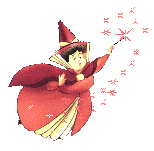
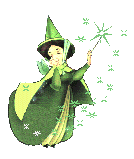

![]() Candy Candido hit it big as the talking tree in The Wizard of Oz
(1939), then used his voice talents as the Indian Chief in Peter
Pan (1953), the crocodile in Robin
Hood (1973), Nero and Brutus in The
Rescuers (1977) and last but not least, Fidget in The
Great Mouse Detective (1986).
Candy Candido hit it big as the talking tree in The Wizard of Oz
(1939), then used his voice talents as the Indian Chief in Peter
Pan (1953), the crocodile in Robin
Hood (1973), Nero and Brutus in The
Rescuers (1977) and last but not least, Fidget in The
Great Mouse Detective (1986).
![]() Pinto Colvig was the voice of Grumpy and Sleepy in Snow
White & the Seven Dwarfs (1937), the flamingoes in Alice
in Wonderland (1951) and Goofy in several animated movies.
Pinto Colvig was the voice of Grumpy and Sleepy in Snow
White & the Seven Dwarfs (1937), the flamingoes in Alice
in Wonderland (1951) and Goofy in several animated movies.
![]() Bill Thompson is the actor behind the most Disney characters from the 1950s:
Bill Thompson is the actor behind the most Disney characters from the 1950s:
- the White Rabbit and Dodo in Alice
in Wonderland (1951)
- Mr. Smee and several pirates in Peter
Pan (1955)
- Bull, Dachsie, Jock and Joe in Lady
& the Tramp (1955)
He finished his career more more quietly, as Uncle Waldo in The
Aristocats (1970)!
![]() Don Bluth (An American Tail, The Land Before Time, Anastasia,
Titan
A.E.) started his career as an inbetweener in Sleeping Beauty.
A former Mormon missionary, he left Disney after working on this movie,
in order to pursue personal interests. Hired back in the 70's to
help rebuild the aging Disney animation crew, he once again walked out
of Disney in 1979, taking with him Gary Goldman, John Pomeroy, and 14 other
promising animators with whom he had been secretly working on films in
his garage. He claimed that Disney was skimping on production values,
calling their stories "saccharine mush" despite his own propensities...
which doesn't make him any less talented!
Don Bluth (An American Tail, The Land Before Time, Anastasia,
Titan
A.E.) started his career as an inbetweener in Sleeping Beauty.
A former Mormon missionary, he left Disney after working on this movie,
in order to pursue personal interests. Hired back in the 70's to
help rebuild the aging Disney animation crew, he once again walked out
of Disney in 1979, taking with him Gary Goldman, John Pomeroy, and 14 other
promising animators with whom he had been secretly working on films in
his garage. He claimed that Disney was skimping on production values,
calling their stories "saccharine mush" despite his own propensities...
which doesn't make him any less talented!

![]() Princess Aurora
was influenced by Audrey Hepburn.
Princess Aurora
was influenced by Audrey Hepburn.
![]() Walt wanted the
fairies to be identical but the animators scrapped that idea. The
fairies were inspired by watching old ladies at a local supermarket.
Walt wanted the
fairies to be identical but the animators scrapped that idea. The
fairies were inspired by watching old ladies at a local supermarket.
![]() Mary Costa recalled
in 2003 that Walt Disney himself lectured her on the fine points of voicing
a cartoon. "I was always a little bit nervous because I was in awe of him.
He said that he was very pleased with what I was doing but that he always
wanted me to keep my voice very clear. He said, 'You protect yourself so
that you don't get a cold,' and he said, 'Before the recording sessions
you be sure that you have a warm meal at least two hours before.' He said,
'You be sure you always exercise the vocal cords before you come over,
hum or read lightly. Always have at least nine hours of sleep before you
come over for a recording session, and always do some physical exercise
to get yourself ready. The entire thing is a physical exercise.'" Costa
said she didn't realize until years later why he showed such particular
interest in her voice work. "It dawned on me that he had done [the voice]
of Mickey Mouse
for so many years, and he had to keep that voice high. So he had to do
all those things." A soprano with a 3 1/2-octave range, Mary Costa traveled
the world in a career spanning four decades.
Mary Costa recalled
in 2003 that Walt Disney himself lectured her on the fine points of voicing
a cartoon. "I was always a little bit nervous because I was in awe of him.
He said that he was very pleased with what I was doing but that he always
wanted me to keep my voice very clear. He said, 'You protect yourself so
that you don't get a cold,' and he said, 'Before the recording sessions
you be sure that you have a warm meal at least two hours before.' He said,
'You be sure you always exercise the vocal cords before you come over,
hum or read lightly. Always have at least nine hours of sleep before you
come over for a recording session, and always do some physical exercise
to get yourself ready. The entire thing is a physical exercise.'" Costa
said she didn't realize until years later why he showed such particular
interest in her voice work. "It dawned on me that he had done [the voice]
of Mickey Mouse
for so many years, and he had to keep that voice high. So he had to do
all those things." A soprano with a 3 1/2-octave range, Mary Costa traveled
the world in a career spanning four decades.
![]() Walt personally
recommended Eleanor Audley as the voice of Maleficient.
Walt personally
recommended Eleanor Audley as the voice of Maleficient.
![]() Ollie Johnston
says that originally Disney toyed with the idea that Flora, Fauna and Merryweather
should all look the same. "He said, 'We don't need them to be all different,'
" Johnston, 90, recalled in August 2002. "But it would have lacked the
entertainment." As with many of Disney's animated films that featured human
characters, a live-action version was filmed for the animators to use as
models. Johnston says that he and Thomas also observed older women shopping
in super markets in order to create the three fairies. "We got to stare
at old ladies and watched them to see how they behaved and whether they
talked to each other," Johnston recalls with a laugh. "We had fun with
it."
Ollie Johnston
says that originally Disney toyed with the idea that Flora, Fauna and Merryweather
should all look the same. "He said, 'We don't need them to be all different,'
" Johnston, 90, recalled in August 2002. "But it would have lacked the
entertainment." As with many of Disney's animated films that featured human
characters, a live-action version was filmed for the animators to use as
models. Johnston says that he and Thomas also observed older women shopping
in super markets in order to create the three fairies. "We got to stare
at old ladies and watched them to see how they behaved and whether they
talked to each other," Johnston recalls with a laugh. "We had fun with
it."
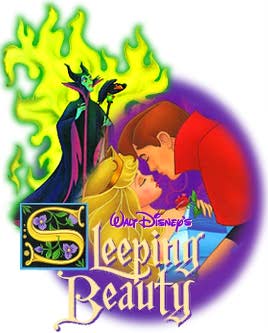
![]() This is the first
Disney animated feature having both parents of the hero/heroine present
and alive and the only one with a human princess/heroine. It is also
the first Disney animated feature with a named human prince -or hero for
that matter!
This is the first
Disney animated feature having both parents of the hero/heroine present
and alive and the only one with a human princess/heroine. It is also
the first Disney animated feature with a named human prince -or hero for
that matter!
![]() There is a definite
"break" in the film. Once Aurora learns her true identity and Phillip decides
to run away from his arranged marriage, you may notice that the colors
change slightly. Also Aurora and Phillip do not have any more spoken lines
after that point.
There is a definite
"break" in the film. Once Aurora learns her true identity and Phillip decides
to run away from his arranged marriage, you may notice that the colors
change slightly. Also Aurora and Phillip do not have any more spoken lines
after that point.
![]() Charles Shows
worked for many years with Disney as a writer-producer, and published a
collection of anecdotes about the master of the Magic Kingdom: "Since critics
had often called Walt Disney's art "old-fashioned," he decided to try to
improve his artistic image. One of America's top artists, Eyvind Earle,
was brought in to develop a new, more modern visual style for the art backgrounds
for Walt's new feature-length animated cartoon classic. Every day,
Eyvind spent eight to ten hours painting, lulled by the strains of taped
classical music. He created exquisitely beautiful backgrounds, about three
feet in width and one foot high. Day in and day out, week after week, Eyvind
painted the bright, colorful, inspired backgrounds. As he completed each
painting, he hung it on the studio wall like a valuable art treasure. With
the taped background music inspiring him to even greater heights of expression,
Eyvind soon covered the walls with his paintings and started hanging the
priceless work in the halls. Though Walt had commissioned Eyvind to create
a more modern art style for Sleeping Beauty, he never came by to see how
the famed artist was progressing. I began to wonder if Walt had completely
forgotten about the backgrounds. I didn't know how much the artist was
being paid, but I knew Eyvind Earle didn't work cheap. It must have cost
the studio a fortune as he sat, month after month, painting backgrounds
that Walt never looked at. At last the day arrived when Walt appeared.
He walked into Eyvind's room to see how the new, modern backgrounds were
coming along. Walt examined them carefully, one by one, not saying a word.
He inspected every tree, every flower, every cloud, every raindrop, for
what seemed like an eternity -especially to the silent Eyvind Earle, who
watched him anxiously, waiting for the final appraisal of his hundreds
of hours of work. Finally Walt turned to the nervous artis and gave
his final verdict in four words. "Not quite that modern," was all he said.
Eyvind Earle defeatedly sank into his chair, muttering angrily to himself.
But even his quiet retorts didn't console him, for he knew that Walt couldn't
possibly shove all those paintings where Eyvind had suggested he shove
them!"
Charles Shows
worked for many years with Disney as a writer-producer, and published a
collection of anecdotes about the master of the Magic Kingdom: "Since critics
had often called Walt Disney's art "old-fashioned," he decided to try to
improve his artistic image. One of America's top artists, Eyvind Earle,
was brought in to develop a new, more modern visual style for the art backgrounds
for Walt's new feature-length animated cartoon classic. Every day,
Eyvind spent eight to ten hours painting, lulled by the strains of taped
classical music. He created exquisitely beautiful backgrounds, about three
feet in width and one foot high. Day in and day out, week after week, Eyvind
painted the bright, colorful, inspired backgrounds. As he completed each
painting, he hung it on the studio wall like a valuable art treasure. With
the taped background music inspiring him to even greater heights of expression,
Eyvind soon covered the walls with his paintings and started hanging the
priceless work in the halls. Though Walt had commissioned Eyvind to create
a more modern art style for Sleeping Beauty, he never came by to see how
the famed artist was progressing. I began to wonder if Walt had completely
forgotten about the backgrounds. I didn't know how much the artist was
being paid, but I knew Eyvind Earle didn't work cheap. It must have cost
the studio a fortune as he sat, month after month, painting backgrounds
that Walt never looked at. At last the day arrived when Walt appeared.
He walked into Eyvind's room to see how the new, modern backgrounds were
coming along. Walt examined them carefully, one by one, not saying a word.
He inspected every tree, every flower, every cloud, every raindrop, for
what seemed like an eternity -especially to the silent Eyvind Earle, who
watched him anxiously, waiting for the final appraisal of his hundreds
of hours of work. Finally Walt turned to the nervous artis and gave
his final verdict in four words. "Not quite that modern," was all he said.
Eyvind Earle defeatedly sank into his chair, muttering angrily to himself.
But even his quiet retorts didn't console him, for he knew that Walt couldn't
possibly shove all those paintings where Eyvind had suggested he shove
them!"
![]() The score was
nominated for an Academy Award, Best Score for a Musical Picture in 1959.
The score was
nominated for an Academy Award, Best Score for a Musical Picture in 1959.
![]() Both Disneyland
and Disneyland Paris (formerly EuroDisney) have Sleeping Beauty's Castles.
Disneyland's was originally going to be Snow White's Castle but with the
impending release of Sleeping Beauty, Walt thought it would be good publicity
to rename the castle.
Both Disneyland
and Disneyland Paris (formerly EuroDisney) have Sleeping Beauty's Castles.
Disneyland's was originally going to be Snow White's Castle but with the
impending release of Sleeping Beauty, Walt thought it would be good publicity
to rename the castle.
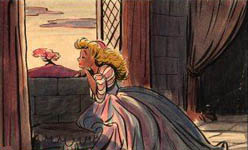 |
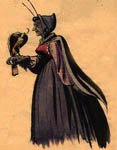 |
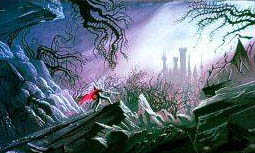 |
 |
During the 1950's, many critics were praising the UPA studios for their stylistic experimentation, while accusing Disney animation of being too "old fashioned". In response, Walt Disney planned his masterpiece, Sleeping Beauty, a film that would merge modern design sensibilities with state-of-the-art wide-screen and stereophonic sound technology.
Walt originally wanted to make Sleeping Beauty right after Snow White and the Seven Dwarfs in the late 1930s, but didn't like the early storyboard. He also felt that the technology wasn't there to make it the way he wanted. It is interesting to note that several sequences in Sleeping Beauty, including the dance with the Scarecrow Prince and the scenes of the Prince's capture and imprisonment, were originally planned for Snow White, but were cut from the film before they could be animated. Two decades later, they were incorporated into Sleeping Beauty.
In early stages of development, the three Good Fairies were to have power over the domains of nature. Flora was in charge of plants and flowers, Fauna oversaw the animal kingdom, and Merryweather controlled the climate. Walt decided to abandon this approach to simplify the story and focus on the fairies' personalities, but the delightful names remained.
From the start, Walt Disney wanted Tchaikovsky's beloved 1889 "Sleeping Beauty Ballet" to be the basis for his film's score. The idea was dropped during early development because some felt the classical music would bog the film down. Walt was dissatisfied with the Studio-created melodies and resurrected the idea of adapting Tchaikovsky's powerful music. "They've been stealing from Tchaikovsky for years," Walt pointed out. "Here's a chance for somebody to steal legitimately from Tchaikovsky." The music of Tchaikovsky is also heard in Fantasia (1940) ("The Nutcracker Suite").
 Walt
Disney combined all the elements to make this film a masterpiece. Disney
staff composer George Bruns adapted Tchaikovsky's "Sleeping Beauty Ballet"
for the animated film. A versatile musician, George also composed the music
for "The Ballad of Davy Crockett." The "Sleeping Beauty" score was nominated
for an Academy Award.
Walt
Disney combined all the elements to make this film a masterpiece. Disney
staff composer George Bruns adapted Tchaikovsky's "Sleeping Beauty Ballet"
for the animated film. A versatile musician, George also composed the music
for "The Ballad of Davy Crockett." The "Sleeping Beauty" score was nominated
for an Academy Award.
Personally cast by Walt Disney as the voice of Maleficent, the evil fairy, Eleanor Audley also spoke for two other members of Disney's sinister sorority: the Wicked Stepmother in Cinderella (1950) and, at Disneyland Park, Madame Leota, the Haunted Mansion's medium in the crystal ball.
The voice of good fairy Flora was perfomed by Verna Felton, who in addition to providing other Disney voices, vocalized for another fairy, Cinderella's Fairy Godmother. Merryweather is voiced by Barbara Luddy, who was the voice of Lady in Lady and the Tramp (1955) and Kanga in the Winnie the Pooh featurettes. The voice of Fauna was Barbara Jo Allen, famous for a Fauna-like character called Vera Vague on Bob Hope's popular radio program.
Animator Eric Cleworth based the deadly, darting head movements of the Maleficent-turned-dragon on those of a striking rattlesnake. Disney technicians used the sound of flame-throwers from army training films for the dragon's fire-breathing blasts.
The eerie, inhuman voice calling "Aurora" during the princess' walk up the tower steps was created by recording the vibrations of the vocal cords of a person speaking the name and playing the oboe at the same time.
The live-action model for Prince Phillip was Ed Kimmer, who inspired animators at the height of his fame as the star of "Space Patrol," one of the 1950s' most popular television series. The live-action model for Prince Phillip as a boy was another television star, Cubby O'Brien, one of the most popular Mouseketeers from TV's "Mickey Mouse Club."
The film's backgrounds were done in an radical angular style, based on Russian folk art, to give it a medieval atmosphere. They were so highly detailed that the general audience at the time actually felt disappointed about the foreground animation! Sleeping Beauty was also the first animated feature to be shot in Super Technirama 70 -using two 35mm film prints to create a 70mm film. Last but not least, the music of Tchaikovsky's Sleeping Beauty Ballet was adapted for the film's soundtrack.
In his quest for quality, Disney allowed his top artists: Marc Davis, John Lounsbery, Milt Kahl, Eric Cleworth, Frank Thomas, Ollie Johnston and John Sibley, extra time to pencil test and refine their scenes until they were absolutely perfect. Sleeping Beauty would be the last animated feature to receive Walt's full attention, but since his time was also required in Anaheim for the building of Disneyland, he was often away from the studio for weeks at a time. To keep busy, animators who were waiting for approvals often did their own inbetweening and preliminary clean-up on their scenes. The movie consequently took an extremely long 6 years to make!
These delays and Disney's unrelenting attention to detail ended up driving the budget up to an alarming 6 million dollars. "I sorta got trapped," Walt admitted later. "I had passed the point of no return and I had to go forward with it."
 On
January 30, 1959, Walt Disney gave the world a sneak peek at his latest
animated masterpiece on his weekly television program. (Now entitled "The
Wonderful World of Disney," Sunday evenings on ABC, the series was then
called "Walt Disney Presents," broadcast on ABC on Wednesday nights.) Entitled
"The Peter Tchaikovsky Story" and featuring scenes from the just-released
film, the program was the first TV show to be simulcast in full stereo.
(Viewers placed an FM radio near their TV sets to achieve the effect.)
On
January 30, 1959, Walt Disney gave the world a sneak peek at his latest
animated masterpiece on his weekly television program. (Now entitled "The
Wonderful World of Disney," Sunday evenings on ABC, the series was then
called "Walt Disney Presents," broadcast on ABC on Wednesday nights.) Entitled
"The Peter Tchaikovsky Story" and featuring scenes from the just-released
film, the program was the first TV show to be simulcast in full stereo.
(Viewers placed an FM radio near their TV sets to achieve the effect.)
Produced in the ultra-widescreen 70 mm process of Technirama 70, "Sleeping Beauty" was screened only at select theaters for its initial roadshow-style release. Theaters chosen for these special engagements (such as the Wilshire in Los Angeles) were provided with special preview trailers that proclaimed "Only in this theater in this area can you experience Sleeping Beauty as Walt Disney visualized its perfect presentation."
Just as with Fantasia in 1940, Sleeping Beauty wasn't a huge hit when it was released, grossing just $5.3 million in its initial release and receiving mixed reviews from the critics, many of whom thought the film was too elaborate for such a simple story. Bosley Crowther of the New York Times even criticized the climactic battle sequence between Maleficent and Aurora's intended, Prince Phillip, as too scary for children, describing the fight as "the noisiest and scariest go-around [Disney] has ever put into one of his films."
Combined with the cost overruns of Disneyland, the film drove the studio very close to bankruptcy, but the effort and sacrifice were definitely worthwhile! Sleeping Beauty remains one of the most accomplished films in movie history.
"I do think it was ahead of its time," says Aurora's voice Mary
Costa. "It was innovative, and the backgrounds were so exquisite. It is
an art piece." Scott MacQueen, who restored the movie in 1997, says when
the film was released, movies were "getting a little bit tougher and more
realistic. It had to compete in that market. There wasn't quite the market
for fairy tales at that time than there previously had been." Sleeping
Beauty also had a distinctly different style than the previous animated
features that many animation fans had a hard time warming up to. "It is
like nothing they have done before or since," says MacQueen. "People who
are in love with the old style, that whole European fluid-color look of
the early features, sometimes reject it because of its hard geometry and
its bright color. But it uses that very graphic style brilliantly."
By Kevin Yee from MousePlanet.
Sleeping Beauty is based on the story "Sun, Moon, and Talia". Written by Italian author Giambattista Basile (1575-1632), it can be found in his 1634 posthumous collection of tales called The Pentamerone, which also included very early versions of Snow White and Cinderella and would prove to be a major source of material for both Perrault and the Grimms.
On the birth of his daughter Talia, a king asked all the wise men and seers to tell her future. They concluded that she would be exposed to great danger from a splinter of flax. To prevent any such accident, the king ordered that no flax or hemp should ever come into his castle. But one day when Talia had grown up, she saw an old woman who was spinning pass by her window. Talia, who had never seen anything like it before, was therefore delighted with the dancing of the spindle. Made curious, she took the distaff in her hand and began to draw out the thread. A splinter of hemp got under her fingernail and she immediately fell dead upon the ground. The king left his lifeless daughter seated on a velvet chair in the palace, locked the door, and departed forever, to obliterate the memory of his sorrow.
 Some
time after, another king was hunting. His falcon flew into a window of
the empty castle and did not return. The king, trying to find the falcon,
wandered in the castle. There he found Talia as if asleep, but nothing
would rouse her. Falling in love with her beauty, he cohabited with her;
then he left and forgot the whole affair. Nine months later Talia gave
birth to two children, all the time still asleep. They nursed from her
breast. Once when one of the babies wanted to suck, it could not find the
breast, but got into its mouth instead the finger that had been pricked.
The baby sucked it so hard that it drew out the splinter, and Talia was
roused as if from deep sleep.
Some
time after, another king was hunting. His falcon flew into a window of
the empty castle and did not return. The king, trying to find the falcon,
wandered in the castle. There he found Talia as if asleep, but nothing
would rouse her. Falling in love with her beauty, he cohabited with her;
then he left and forgot the whole affair. Nine months later Talia gave
birth to two children, all the time still asleep. They nursed from her
breast. Once when one of the babies wanted to suck, it could not find the
breast, but got into its mouth instead the finger that had been pricked.
The baby sucked it so hard that it drew out the splinter, and Talia was
roused as if from deep sleep.
One day the king remembered his adventure and went to see Talia. He was delighted to find her awake with the two beautiful children, and from then on they were always on his mind. The king's wife found out his secret, and on the sly sent for the two children in the king's name. She ordered them cooked and served to her husband. The cook hid the children in his own home and prepared instead some goat kids, which the queen served to the king. A while later the queen sent for Talia and planned to have her thrown into the fire because she was the reason for the king's infidelity. At the last minute the king arrived, had his wife thrown into the fire, married Talia, and was happy to find his children, whom the cook had saved. The story ends with the verses: "Lucky people, so 'tis said, Are blessed by Fortune whilst in bed."
Perrault kept many of the elements of Basile's tale. But, as usual, Perrault infuses the story with his own unique sense of decorum and logic of the aristocracy. Some of Perrault's changes will look familiar to those who know the eventual Disney result. For instance, Perrault introduces the idea of fairies at the celebration of the child's birth. But the slighted fairy was not invited because no one had thought to invite her - this was not a case of an automatically evil person. The fairies give gifts much like we'll later see in the Disney version, and the king bans all spinning wheels.
After 16 years the king and queen happened to be away, and the princess explored the castle and found an old woman spinning. She touches the spindle and falls asleep. The fairy who altered the prophesy from death to sleep returns, and puts everyone in the castle to sleep - except the king and queen. Perrault, in his courtly wisdom, knows better than to put the ruling body into suspended animation; the result to the country would be anarchy!
The fairy's prophesy was set to last exactly 100 years, during which time the castle became overgrown with trees and thorns. After the specified time had elapsed, the throne had been taken over by a new family, and the prince chanced to go hunting that way when the exact moment of prophesy occurs, and the thorns separate themselves into a path. He follows it to find the princess, and at that exact moment, the 100 years ends and she wakes up. Note there is no kiss!
Both parties are taken with each other, though the prince notices immediately that her clothes are very outdated - leave it to Perrault to be fashion-conscious. At this point an important translation issue occurs. We are told that the prince is charmed by her words: "le prince, charmé de ses paroles …" Do you see the proximity of "prince" and "charming"? Except for the comma, one could almost see a typical French construction of "Prince Charming" here, giving rise to what was likely a mistranslation picked up by most English translations and culminating in Disney's Prince Charming (who shows up in Snow White, not in Sleeping Beauty).
They marry immediately, but the prince keeps it a secret from his parents since he fears that his mother, an ogress, will eat his new children. Indeed, she attempts just that after the prince becomes king and has to leave for business. She is stopped only because he returns fortuitously in time to save his wife and children.
At first blush, it looks like most of the eventual Disney tale comes from the Perrault version. Even the title! The sleeping princess is not named in Perrault, but the story itself provides the impetus: "La belle au bois dormant." If you speak French, you may recognize that the common English translation is actually a little off. Correctly translated, the title is: "The Beauty of the Sleeping Woods."
The Grimms' version inches closer to the Disney version. The story follows Perrault's pretty closely, with minor exceptions here and there (the 13th fairy, for instance, is not invited because the king ludicrously lacks enough place settings). The Grimms change the trees and forest into simply large brambles of thorns, which gives the girl the name "Briar Rose" in the legends during her slumber. In the Grimms' version, countless youths try to approach the castle, only to be rebuffed by the thorns until they are impaled upon them and killed. It is likely that the Grimms' bloodthirstiness here indicates that the "incorrect" suitors are akin to morally corrupt villains elsewhere in their tales: the good are rewarded, but the morally bad characters are always punished.
Once again the prince gains access to the castle simply by having good timing - the 100 years of the prophesy had just elapsed - but in the Grimms' version we finally get a kiss: "There she lay, so beautiful that he could not turn his eyes away; and he stooped down and gave her a kiss. But as soon as he kissed her, Briar-rose opened her eyes and awoke, and looked at him quite sweetly." Here the Grimms adopt a tone of romantic fantasy that corresponds with the popular literature sweeping Germany at the time, a positive Romanticism that far outstrips Wordsworth's later efforts in England. There is no need for talking - let alone fashion comparisons - for love conquers death in this retelling.
The largest contributions by the Grimms, then, are the prominence of the thorns and the presence of "love at first sight" - finally we have romance in the story. It is worth noting that the Grimms' princess is just as passive as that of Perrault and Basile: this girl waits for her prince to come to her.
Significant also is that the Grimms omit the "afterstory" of cannibalism and the ogress. For Basile, the ogress had been a jealous wife, while for Perrault, it was a hungry mother. Shuddering at any notion of cannibalism whatsoever, the Grimms jettison the subplot even before the first manuscript is recorded. Either that, or their sources had never heard the story with the attempted cannibalism at the end, but this was unlikely, as most of their purported illiterate peasants in fact were familiar with Perrault's stories.
By the time Disney tackles the story, another 100 years of evolution and Mother Goose have further watered down the story and softened its edges, and of course Disney provides some unique touches as well: the dragon is new, as is the convention of naming everyone in sight - even the raven is named! Ultimately, Disney takes elements from both Perrault and Grimms. Perrault gives the story its name and has the fairy put the castle to sleep, while the Grimms significantly increase the romance of the story.
An intriguing question to ponder is whether Disney combined source material
for a reason. Snow White was largely true to the Grimms' version, while
Cinderella comes from the Perrault tradition - why should Sleeping Beauty
not choose one tradition to follow? It bears mentioning that this is the
first animated feature released during Walt's lifetime that received substantially
less oversight by Walt himself; he was busy conceiving and building Disneyland
during the film's creation. Would the movie have been radically different
had Walt been as involved as he had been during Snow White? We will probably
never be certain.
|
||||||||||||